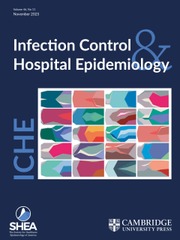No CrossRef data available.
Article contents
Long-range air dispersal as an important source of environmental contamination in Candida auris clustering: possible infection control implication
Published online by Cambridge University Press: 12 November 2025
Abstract
To analyze the correlation between scale of Candida auris clustering and extent of environmental contamination, exploring its implications for improving infection control measures in healthcare settings.
Retrospective observational study.
An acute hospital and a convalescent hospital in Hong Kong.
Laboratory confirmed C. auris carriers diagnosed in two hospitals between March and October 2023.
C. auris screening was conducted on patients with defined risk factors and through regular surveillance. Environmental samples were collected from high-touch surfaces and air grilles in corresponding wards.
One-hundred-seventy new C. auris patients were identified, including 65 from nine outbreaks and 105 sporadic cases. Environmental screening from eight outbreaks and 46 sporadic isolated cases was analyzed. The environmental contamination rate was significantly higher in the outbreak group (15.1% vs 2.6%, P < 0.05). Longer outbreak duration (34 vs 7 days, P < 0.05) and a higher median number of affected patients per outbreak (9 vs 5, P = 0.05) were associated with higher contamination rates. Notably, air grille samples had a significantly higher contamination rate than high-touch surfaces in both the outbreak (31.6% vs 10.2%, P < 0.05) and sporadic groups (4.6% vs 1.5%, P < 0.05).
Prolonged and sizeable C. auris clusterings were linked with more extensive environmental contamination, particularly in air grilles, which are often overlooked during decontamination
These findings underscore the need for enhanced infection control measures, including thorough environmental decontamination of air ventilation systems, to mitigate transmission risks in healthcare settings.
Information
- Type
- Original Article
- Information
- Copyright
- © The Author(s), 2025. Published by Cambridge University Press on behalf of The Society for Healthcare Epidemiology of America
Footnotes
Previous presentation: The preliminary data were presented as poster abstract in IDWeek 2024


